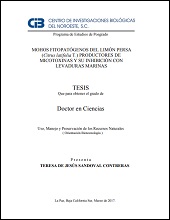| dc.contributor | FELIPE DE JESUS ASCENCIO VALLE | |
| dc.contributor | ANGELICA VILLARRUEL LOPEZ | |
| dc.creator | TERESA DE JESUS SANDOVAL CONTRERAS | |
| dc.date | 2017-03-13 | |
| dc.identifier | http://cibnor.repositorioinstitucional.mx/jspui/handle/1001/434 | |
| dc.identifier.uri | http://dspace.cibnor.mx:8080/handle/123456789/2316 | |
| dc.description | Los mohos además de causar deterioro y grandes pérdidas económicas en frutas y otros alimentos, pueden sintetizar micotoxinas que representan un riesgo para la salud humana y animal. El objetivo general fue caracterizar los mohos fitopatógenos de limón Persa (Citrus latifolia T.) con capacidad micotoxigénica en un medio complejo a base de pericarpio de limón y su inhibición con levaduras marinas. Para cumplir con los objetivos primero se determinó la capacidad micotoxigénica de mohos fitopatógenos para el limón Persa por medio de la búsqueda de secuencias que pertenecen a genes que participan en la biosíntesis de micotoxinas, por PCR convencional. De los mohos positivos a secuencias de genes micotoxigénicos se realizaron cultivos en un medio complejo a base de pericarpio de limón Persa -que se le se denominó Agar Limón (AL)- en diferentes condiciones de pH, temperatura y tiempo de incubación. Se determinó el grado de toxicidad de las micotoxinas producidas por los mohos utilizando bioensayo de toxicidad con A. salina. Por último se identificaron y cuantificaron las micotoxinas por HPLC-MS. Como segundo paso, se analizó la capacidad de síntesis de micotoxinas sobre limón Persa infectado artificialmente con las cepas A. niger y A. carbonarius; se analizaron las diferentes partes del limón y se determinó la difusión de las micotoxinas en el fruto. Finalmente, se determinaron las condiciones para el biocontrol de los mohos con la levadura marina Debaryomyces hansenii. En una primera etapa se modelizó el crecimiento de los diferentes mohos sobre agar limón y se determinó la velocidad de crecimiento teórico, así como el tiempo en que se hace visible la colonia. En la segunda etapa, se evaluó la capacidad inhibitoria tanto de la levadura, como de los sobrenadantes de su cultivo, esto último relacionado con la habilidad de las levaduras de producir proteínas killer contra los microorganismos sensibles, para lo cual se realizaron retos de inhibición de los mohos micotoxigénicos, in vitro, e in vivo. Se encontraron tres cepas positivas a genes participantes en la biosíntesis de micotoxinas: A. alternata positiva al gen PKS (síntesis de melanina, precursor de altertoxina), A. carbonarius positivo al gen PKS (enzima en la policondensacion de cetonas, ruta de la OTA) y A. niger positivo al gen aflL (antes VerB) y FUM1 (síntesis de aflatoxinas y fumonisinas respectivamente) [...] | |
| dc.description | Filamentous fungi, apart from causing damage and great economic losses in fruit and other foods, can synthesize mycotoxins that represent a risk for the health of humans and animals who eat them. The general objective was to characterize the phytopathogenic molds of Persian lime (Citrus latifolia T.) with mycotoxigenic capabilities in a complex medium based of lime pericarp, and their inhibition with marine yeasts. To meet these objectives we first determined the mycotoxigenic capability of Persian lime phytopathogenic molds by using conventional PCR to find sequences that belong to genes participating in the biosynthesis of mycotoxins. The molds that tested positive for mycotoxigenic gene sequences were cultured in a Persian lime pericarp-based complex medium, under different conditions of pH, temperature and incubation time. The degree of toxicity of the produced mycotoxins was tested using a letaly assay with A. salina. Lastly, we identified and quantified the mycotoxins using HPLC-MS. As a second step, we analyzed the mycotoxin synthesis capability on Persian limes infected artificially with the A. niger and A. carbonarius strains; we analyzed the different parts of the lime and determined the diffusion of mycotoxins in the fruit. Finally, we determined the conditions for biological mold control with the Debaryomyces hansenii marine yeast. On the first stage, we determined the growth of the different molds on LA and their theoretical growth velocity, as well as the time before the colony becomes visible. On the second stage, we evaluated the inhibitory capability of the yeast as well as its culture’s supernatants, the latter evaluation related with the ability of the yeasts to produce killer proteins against sensitive microorganisms, for which we performed in vitro and in vivo mycotoxigenic mold inhibition challenges. We found three strains that tested positive for genes participating in mycotoxin biosynthesis: the PKS gene in A. alternata (synthesis of melanin, a precursor of altertoxins), the PKS gene in A. carbonarius (an enzyme for polycondensation of ketones, part of the OTA path), and the aflL and FUM1 genes in A. niger (synthesis of aflatoxins and fumonisins respectively) [...] | |
| dc.format | application/pdf | |
| dc.language | spa | |
| dc.publisher | Centro de Investigaciones Biológicas del Noroeste, S.C. | |
| dc.rights | info:eu-repo/semantics/openAccess | |
| dc.rights | http://creativecommons.org/licenses/by-nc-nd/4.0 | |
| dc.subject | info:eu-repo/classification/AUTOR/mohos fitopatógenos micotoxigénicos; riesgo alimentario; levaduras marinas; antagonismo | |
| dc.subject | info:eu-repo/classification/cti/6 | |
| dc.subject | info:eu-repo/classification/cti/31 | |
| dc.subject | info:eu-repo/classification/cti/3108 | |
| dc.subject | info:eu-repo/classification/cti/310805 | |
| dc.subject | info:eu-repo/classification/cti/310805 | |
| dc.title | Mohos fitopatógenos del limón persa (Citrus latifolia T.) productores de micotoxinas y su inhibición con levaduras marinas | |
| dc.type | info:eu-repo/semantics/doctoralThesis | |
| dc.type | info:eu-repo/semantics/publishedVersion | |


